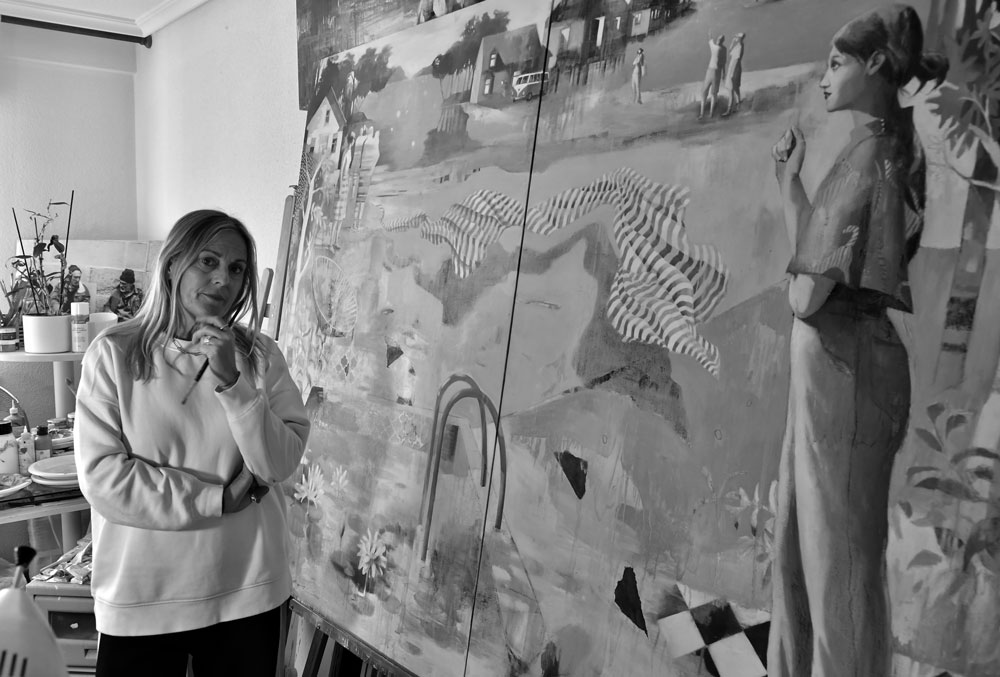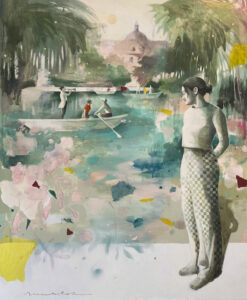LES, 1966 Menchu Uroz

In Menchu Uroz’s work, the fusion between nature and the female figure is manifested in a visual narrative that combines reality with dreams.
Through mixed techniques and the use of traditional and recycled media, he creates compositions that invite reflection on the moments of light and the connections between the characters and their environment.
Menchu Uroz has a degree in Fine Arts from the Faculty of Sant Jordi in Barcelona, specialising in Restoration. In addition to painting for many years, she has made incursions into the restoration of mural paintings, advertising and artistic teaching.
She received the first art prize ‘El Flechazo 2022’ at the contemporary art fair FLECHA. He attended a course given by Antonio López, Francisco de Goya chair in Ávila. One of his works was acquired for the permanent collection in the Museum of the Ducal Palace of Medinaceli in Soria.
In recent years she has exhibited in galleries, museums and art spaces in solo and group exhibitions such as: Sara Caso art gallery in Madrid, Espai 36 gallery in Zamora, collective in the DEARTE Foundation in the Museum of the Ducal Palace of Medinaceli in Soria (image on the cover of the catalogue), NB7 gallery in Madrid, Maes gallery in Madrid, Sala Alta del Real Casino in Murcia, Monsequi gallery in Madrid, L’Arcada art gallery in Blanes, L’Arcada art gallery in Blanes, collective in the Porto gallery in Soria (image on the cover of the catalogue), Espai Cavallers gallery in Lleida, L’Arcada art gallery in Blanes, collective in the Porto gallery with the Espai 36 gallery in Portugal, exhibition hall in Miranda do Douro in Portugal, collective in the Fundación Aguirre Newman in Madrid, exhibition hall of the Ayuntamiento de Toledo, Sala Murillo in Oviedo, La Ribera gallery in Murcia, Sala de exposiciones del Ayuntamiento de Toledo in Spain.
She has also participated in national and international art fairs such as Art Madrid in the last editions in the Palacio de Correos de Cibeles, FLECHA, Estampa, AAF Hamburg, ST-ART Strasbourg, New Art Fair, art fair in Vierheim in Germany, Casa Decor in Madrid, Rodarte in Madrid, Arcale Palma de Mallorca and Bilbao in several editions.
Since childhood she felt this passion for expressing herself with a pencil or a paintbrush, and so he went on to study Fine Arts in Barcelona with the encouragement of his parents. A few years later she moved to Madrid, where she currently lives.
The characteristic elements of her work are nature and the human being. The figures are usually women that she depicts from her feminine vision, inspired by her surroundings.
The style is figurative, nourished by intuition and play, combining the real with the impossible and experimenting with different techniques. In the same work she plays with oil, acrylic, collage, waxes, aerosols and charcoal.
As for the supports, she uses traditional ones such as canvas and wood, although she also recycles wood which, thanks to its knots, tears and cracks, guide her in the layout of her work.
In the composition, she creates sequences that take place in landscapes in which the characters seem to observe something happening around them, captured in moments of light.
In her constant learning, she explores the balance and harmony between form and colour, investigating the interaction between light, shadow and the whole.
MENCHU UROZ “Where I live”
by Isabel Gutiérrez, artist
I first came across Menchu Uroz’s work in an exhibition she presented in Madrid in 2021. Those images, set in museums, full of magic and good work, entered my retina and stayed in my affective memory from the first glance.
In the following years I have followed his career closely, coinciding in different Art Fairs, attending his exhibitions and having interesting conversations about our creative processes. I have followed step by step each of his masterly series, and I have enjoyed the countless visual delights that he gives us in each new work. Therefore, it is a pleasure to be with you today through my words, which will try to take you into the universe of her paintings.
The series Menchu presents in this exhibition is the continuity of her latest themes: landscapes that recreate moments and experiences in different cities or imaginary spaces. In them she admirably combines elements and constructions of reality with reveries arising from nature and objects.
In order to achieve these particular atmospheres, Menchu resolves her spaces with unsaturated colour ranges, enlivened by soft blues, violets, greens, ochres and whites. Small surfaces of more vivid colour enhance the lightness of the surrounding space. Respectful of the classical canons of perspective, she plays at the same time with freer spatial assemblages, in the manner of a visual collage, which invite us to imagine dreamlike, disembodied landscapes. She uses a technique that is not very material, based on veiled oil tones, which contribute to the visual sensation of transparency and dreaminess.
The combination between the backgrounds of her paintings, which play with abstraction, and the characters, figurative in appearance, strategically placed to focus the viewer’s gaze, is noteworthy.
With a play between planning and improvisation, Menchu creates masterly visual lines that accompany the eye imperceptibly over the entire surface of the painting.
The characters Menchu portrays live and let live, they observe, reflect, read, play, relax and wonder, always respecting the presence and freedom of movement of those close to them and strangers. They are travellers, sportsmen, tourists, families, the occasional absent-minded person, all trying in their own way to enjoy the landscapes they inhabit.
In some of her compositions we can see figures gently touching spheres of light suspended in space, which seem to acquire corporeity precisely because of this contact. I believe that Menchu wants to symbolise through these bodies of light, through these spheres, that we should take care and keep as a treasure the purest and most valuable experiences and feelings of our life in our particular ‘heart-sphere’. Menchu leaves in suspension many other spheres in search of her human, so I presume that she encourages us to enter her paintings in order to reach each one of us our own sphere, and to keep in it the best of ourselves.
In other works she shares with us different views of architectural ensembles of exquisite elegance, which she herself has previously discovered and enjoyed, such as Casa Batlló, the chimneys of the La Pedrera building, the Monastery of San Cugat, the recreations of the winged lions of the Parc de la Ciutadella in Barcelona, or the Palacio de Cristal in Madrid, always underpinned by the gaze of her characteristic characters.
Everything in our artist’s work alludes to respect for the conservation of the space we inhabit, to introspection and empathy between human beings.
Let us, then, enter Menchu’s inhabited spaces, as Alice did with the mirror, and place ourselves silently beside her dreamy characters, letting time pass to try, like them, to find the secret of our own identity.

